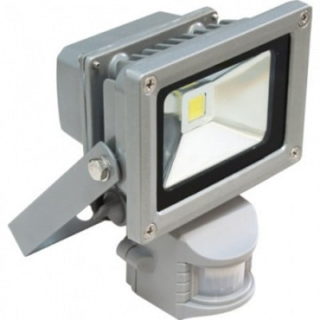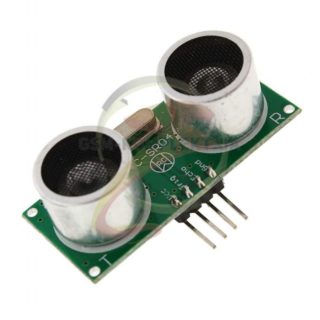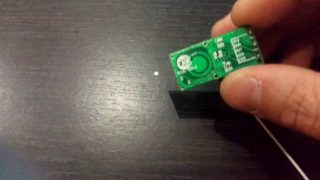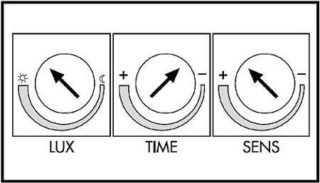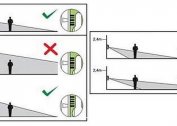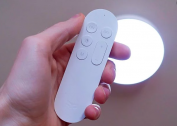Street floodlights are used to illuminate streets and roads, sports and playgrounds, as well as building facades, construction sites, storage areas, etc. They are also installed in places where the presence of constant lighting in the dark is not necessary, and it is inconvenient to use the switch (parking lots , house territories, farmsteads, cottages). In order for the spotlights to turn on and off automatically and only if necessary, they are equipped with motion sensors (DD). At the same time, the correctly assembled kit is a complete automated lighting system that provides significant energy savings.
Types of motion sensors
The effectiveness of the pair of “spotlight + motion sensor” largely depends on the correctly selected DD. In practice, the following are most often used:
- infrared;
- ultrasound
- microwave;
- combined.
All of these sensors have both advantages and disadvantages.
Infrared
The principle of operation of infrared DD (ICDD) is based on the detection of changes in the thermal radiation of objects in the observation zone. When the object moves, its thermal radiation is alternately transmitted by special lenses to the control sensor, which forms a signal to turn on the searchlight. In this case, the sensitivity and size of the controlled area depend on the number and surface area of the lenses.
The disadvantages of ICDD include:
- the possibility of false positives (response to any thermal radiation);
- low accuracy of work on the street due to exposure to direct sunlight and precipitation;
- does not respond to shielded objects that do not transmit infrared radiation;
- insufficient operating temperature range.
The main advantage of ICDD is the high accuracy of adjusting the angle and detection range of moving objects.
Ultrasonic
An ultrasonic wave generator operating at a frequency of 20 to 60 kHz is installed in the ultrasonic DD (UZDD) package. The principle of operation is the registration by the ultrasonic receiver of the frequency changes upon reflection of the ultrasonic wave from a moving object. A signal is received from the receiver to turn on the lighting.
The main advantages of SPD:
- low cost;
- high working capacity in conditions of high dust and humidity;
- the operation of the sensors is not affected by changes in ambient temperature and / or moving objects;
- the material of moving objects has no effect on the operation of the SPD.
Among the shortcomings of the ultrasonic inspection, it is possible to single out a short range of operation and operation only on sudden movements of an object in the observation zone.
Microwave
The principle of operation of the microwave DD is similar to the operation of the ultrasonic inspection. However, unlike the latter, the built-in receiver emits waves with a frequency of about 5.8 GHz of small power (no more than 1 mW / sq. Cm.). When the smallest changes in the frequency of the reflected signal are detected, the microprocessor generates a command to turn on the lighting.
Advantages of the microwave sensor:
- the ability to detect moving objects behind dielectric or weakly conducting electric current obstacles;
- catches minor movements of the object;
- the ability to work at any temperature of air and objects;
- the presence (if necessary) of several observation zones.
When microwave sensors are operating, their response to the movement of objects outside the observation zone is possible.They differ in higher cost. In addition, constantly emitted microwave waves are unsafe for humans.
Combined
Combined sensors combine several motion detection methods. The most successful in this case is the joint work of the IR and microwave sensors. In parallel, the motion detection channels make the combined sensor work most efficient and accurate.
How to connect motion sensors to a spotlight
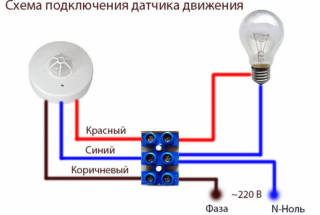 The connection diagram of the motion sensor to the spotlight is so simple that anyone who is familiar with the basics of electrical engineering and the rules for conducting electrical work can assemble it. The DD acts as a circuit breaker and must be connected between the spotlight and the power outlet. To connect the DD to the spotlight, you will need a screwdriver, electrical tape, pliers, a mounting knife, a soldering iron, a multimeter, electrical wires of the required length (with autonomous installation of the DD). The presence of a screwdriver does not hurt.
The connection diagram of the motion sensor to the spotlight is so simple that anyone who is familiar with the basics of electrical engineering and the rules for conducting electrical work can assemble it. The DD acts as a circuit breaker and must be connected between the spotlight and the power outlet. To connect the DD to the spotlight, you will need a screwdriver, electrical tape, pliers, a mounting knife, a soldering iron, a multimeter, electrical wires of the required length (with autonomous installation of the DD). The presence of a screwdriver does not hurt.
If the DD is built into the spotlight housing, no electrical work is necessary. They are needed in cases where the DD is installed autonomously directly near the spotlight or at a distance from it.
Connection Order
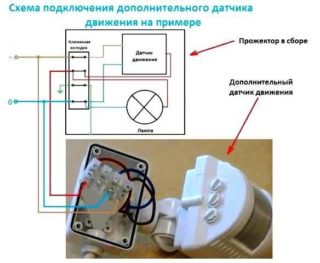
Connect the DD to the spotlight as follows:
- Disassemble the DD - inside there is a terminal block with three conductors connected to it blue (zero), brown (power supply phase)), red (load). TsThe conductors may differ from the indicated ones, therefore it is recommended to ring with a multimeter for reliability of the wire.
- Disassemble the spotlight - inside there are two wires: zero (blue) and phase (red).
- Connect the searchlight to the DD, for which they connect (red and blue wires (zero) between themselves (via the terminal block).The contact terminal “zero” must connect all three components - the mains, spotlight and DD. To do this, you need to twist the stripped tip of one wire from the power cable with a blue conductor from the spotlight and then connect it to the blue wire of the DD through the terminal block.
- Insert the stripped tip of the phase wire of the power cable into the remaining terminal block socket.
- After checking the correspondence of the wires interconnected and finally tightening the screws in the terminals of the terminal block, they collect the DD and the searchlight.
Next, you can connect the system to the power supply and begin to test and configure it.
DD can work with spotlights, in which incandescent, halogen, LED, fluorescent lamps can act as a light source. At the same time, the connection scheme remains unchanged.
The use of powerful spotlights will require the inclusion of special contactors (magnetic starter) in the wiring diagram, which remove part of the load from the DD contacts.
DD adjustment
When installing a spotlight with a DD, first of all, the device is set up so that the observation area is the largest. The height of the placement and the angle of its installation are important in this case. The installation angle is adjusted using a swivel mount, and the vertical viewing parameters are indicated in the operating instructions.
The operating parameters of the floodlight with DD are set using the controls, the handles of which are displayed on the sensor housing for convenience. They are located at the bottom of the DD and are marked accordingly.
Sens (sensitivity) - controls the intensity of the movement to which DD should respond. First, it is recommended to set the regulator to maximum and check how the sensor responds to the appearance of a moving object in the observation area (person, car, etc.). Typically, the detection distance is 2-8 m. DD should not respond to flying birds and swaying tree branches.
Lux (illumination) - adjusting the illumination level, set the control to MIN. In this case, DD will work only in complete darkness. If necessary, the light level is changed.
TIME (delay time) - sets the operating time of the spotlight after a moving object leaves the surveillance zone. As a rule, the time delay is set in the range of 5 seconds. up to 8 minutes
